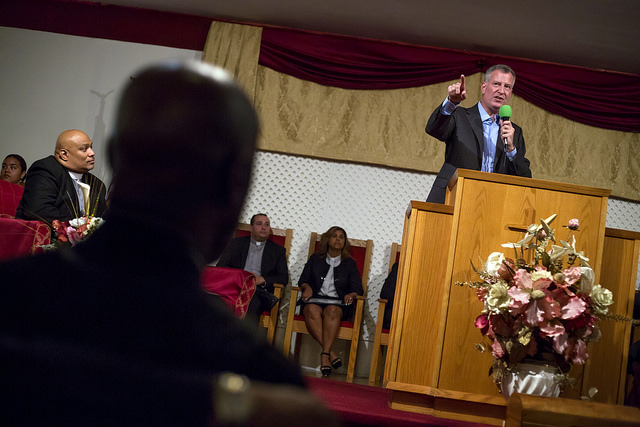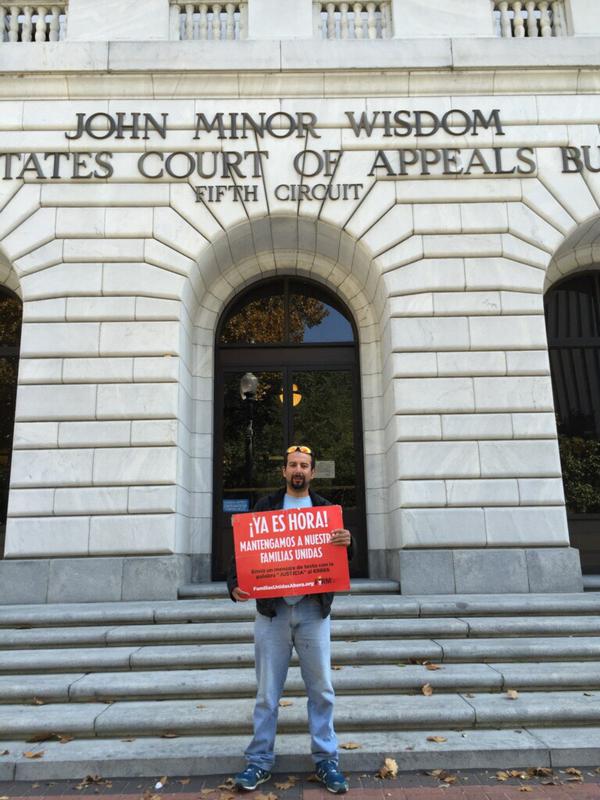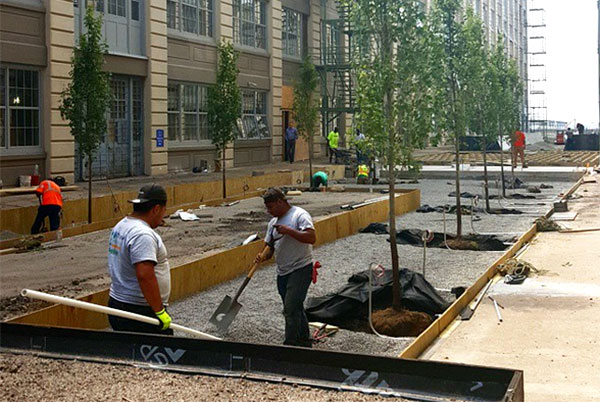A More Cost-Effective Adult Homeless Services System

Mayor de Blasio (Ed Reed/Mayoral Photography Office)
Last week, the New York City Independent Budget Office published a fiscal brief -Albany Shifts the Burden: As the Cost for Sheltering the Homeless Rises, Federal & City Funds Are Increasingly Tapped- detailing the financing of city homeless shelters from 2007 to 2014. The brief sheds light on the imminent need for reform of the single adult homeless services system. It also provides a roadmap that the City and State should follow to address the issue in a cost-effective manner.
In particular, the IBO report illuminates the rising costs of sheltering single homeless adults. From 2007 to 2014, city shelter costs for the population more than doubled, rising from $196 million to $343 million (75 percent increase). Aghast to think, the financial cost of single adult homelessness in New York City is actually above $343 million, though.
As IBO acknowledges, $343 million is merely the cost to shelter those associated with the Department of Homeless Services. There is also the cost to shelter domestic violence victims, persons with HIV/AIDS, and runaway youth through the Human Resources Administration and Department of Youth and Community Development. In addition, there is the cost of outreach programs, drop-in centers, and respite beds ($35 million in 2014) to bring homeless individuals inside. There are also the public institutional costs of street homelessness: $40,000 per individual per year, as of 2012, according to former Housing and Urban Development Secretary Shaun Donovan.
The IBO brief also reveals the increasing financial share that New York City pays to shelter single homeless adults. State changes in funding rules have shifted single adult shelter costs from the State towards the City. In 2007, the City funded 53 percent ($104 million) of the single adult shelter cost. However, in 2014, the City funded 73 percent ($252 million).
The IBO brief recommends that since the City largely goes it alone in funding single adult shelters, it should focus on reducing the single adult census. As a nonprofit that has worked for forty years to provide this population a way home, Urban Pathways encourages the City and State to focus on the following.
Paramount is the City and State funding effective exit options. First and most important is a new supportive housing agreement, a NY/NY IV. The first three agreements were extremely successful in stably housing homeless adults. More than 86 percent of NY/ NY III tenants remained housed after one year. More than three-quarters of homeless individuals remained housed after two years. Supportive housing is also cost-effective. It costs significantly less per day than shelter ($55, as opposed to $78).
The second exit option is a more long-term and jointly-financed Living in Communities (LINC) rental subsidy program for homeless adults. Admirably, the City initiated, and is solely funding, several rental subsidies. It is unrealistic for the City to sustain this investment in the long term without a commitment of matching funds from the State and Federal governments.
Additionally, a more long-term, State- and City-financed rental subsidy may also appease currently resistant landlords, freeing up needed apartments. Right now, it is difficult to get landlords to accept the LINC voucher. They can get higher rents from other tenants, and they harbor concerns from the demise of the Work Advantage program.
Also important is that the City and State governments reassess the single adult homeless services system. Currently, it is chiefly a one-size-fits-all model of large shelters. However, just as LINC vouchers are tailored to specific populations, the single adult system should be tailored to its populations. For example, for the chronically homeless that often choose the streets over shelter, the City should divert dollars from shelters to alternatives to shelters such as drop-in centers and safe havens. In conjunction, for single adults at risk of homelessness, the City should divert dollars from shelter to Homebase prevention to provide housing mediation, short-term financial assistance and anti-eviction programs.
***
Nicole Bramstedt is Policy Analyst at Urban Pathways, a nonprofit social services and supportive housing organization. On Twitter at @UrbanPathwaysNY
***
Have an op-ed idea or submission? E-mail editor Ben Max: This email address is being protected from spambots. You need JavaScript enabled to view it.
Why I'm Fasting for Immigration Relief

Mauricio Jiménez, the author (photo via Make The Road NY)
I came to the United States more than twelve years ago from my home in Ecuador. I had to leave my country, because, as a journalist who had written about criminals, I feared retaliation. Living here—first in Washington, D.C., and now in New York—hasn't been easy. In that time, I've been undocumented, experienced and witnessed employers stealing immigrant workers' wages, and seen—time and again—the injustices that immigrants face in this country.
Because of my experiences, I decided to join the fight for the rights of immigrants and workers. In recent years, I've joined my fellow immigrants to demand justice at the local, state, and federal levels on issues including wage theft, the minimum wage, and immigration reform.
This week, I've traveled to New Orleans to join immigrants from around the country to denounce another grave injustice against our community, which has serious effects in New York: a federal court is stalling on ruling on President Obama's immigration relief program, Deferred Action for Parents of Americans and Lawful Permanent Residents (DAPA). In response, immigrants like me from around the country are fasting this week to demand that the 5th Circuit rules quickly so that millions of immigrants can get the relief they need. We are now in the eighth day of our fast.
Last year, President Obama announced the DAPA program and related forms of immigration relief, which would benefit millions of immigrants by enabling them to come out of the shadows, get work authorization, apply for driver's licenses, and live without the fear of being separated from their families.
Since then, anti-immigrant Republican politicians filed a lawsuit to stop DAPA from taking effect, and they intentionally filed it in one of the most conservative courts—and appellate jurisdictions—in the country. Now, the 5th Circuit Court of Appeals appears to be playing a cynical political game and delaying issuing its ruling so that, if it rules against DAPA, the Department of Justice will not be able to have its appeal heard by the Supreme Court before the 2016 elections.
In other words, far-right judges are playing along with far-right politicians to prevent immigration relief from taking effect. The result is simple and disastrous: if they do not issue their decision immediately, millions of immigrant families will remain at risk of being torn apart, instead of living with the peace of mind they need.
This is personal for me and my community. For my family and friends, DAPA would make an enormous difference. We will not stand by idly and permit a court to keep our families in limbo. This week, we are showing that we are willing to put our bodies on the line to ensure that justice is done.
The Court must rule immediately so that the immigration relief provided by DAPA can move forward. We're going to continue fighting for DAPA until it's a reality, and then we will continue the fight for immigration reform that provides a path to citizenship for all 11 million undocumented immigrants, 500,000 of whom live in New York City. We will not stop fighting until we win.
***
Mauricio Jiménez is a Board Member of Make the Road New York, the largest grassroots community organization in New York offering services and organizing the immigrant community. On Twitter: @maketheroadny.
There is Nothing Innovative About Displacement

Industry City courtyard development (photo: Industry City on Instagram)
Sunset Park is at a crossroads. With one of the city’s few remaining industrial waterfronts in a heavily, working-class Latino-Asian neighborhood, its development looms large in shaping the future of New York City and, dare I say, the city’s soul.
Since the March announcement of a $1 billion investment by Industry City’s owners – a consortium of commercial real estate titans - the most dramatic changes along the waterfront have not been the building upgrades, bicycle racks, summer dance parties, or high-end artisanal purveyors. Rather, it is the stupefying number of speculative sales of industrial real estate.
Jamestown Properties is working hard to rebrand Industry City as a site for cutting edge, modern manufacturers in technology, media, design, and high-value added fashion and food production. The developer is working to placate community concerns that the Williamsburg experience of massive displacement and gentrification will not be repeated.
To this end, Jamestown Properties announced the establishment of an “Innovation Lab” in collaboration with CUNY; Southwest Brooklyn Industrial Development Corporation, which manages Sunset Park’s Industrial Business Zone; and several community non-profit social service and workforce organizations. Largely funded by public dollars, the Innovation Lab seeks to connect the neighborhood’s immigrant, non-English speaking labor force with low levels of formal education to the innovation economy.
While Andrew Kimball’s success at the Brooklyn Navy Yard should reassure us that his expertise is preserving and promoting industrial jobs and small businesses, Mr. Kimball’s employer is no longer a non-profit organization that manages city-owned properties.
The redevelopment of Industry City is not about modern manufacturing. Industry City is a commercial real estate venture and its rezoning proposal will make that crystal clear. Most of Industry City’s 16-building complex is in a heavy manufacturing M3-1 zone which prohibits retailers and hotels (unlike light manufacturing M1-1 zones). Industry City’s “unprecedented” development proposal entails designating a “special innovation zoning district” to permit a hotel, university facility (some say dormitory), conference center, and retailers.
Industry City’s consortium of owners has hired Fox Rothschild LLP to prepare its rezoning proposal. A website search of Fox Rothschild LLP’s recent projects lists one for New York City – Ian Schrager’s ultra-luxury, condo-hotel at 215 Chrystie Street on the Lower East Side.
Referencing the area’s industrial past, Schrager describes his 28-story, Public Hotel project as “refined gritty” and “tough luxe.” While one journalist described this branding as “enough to make you lunge for the barf bag,” the transparent and cavalier manner in which the lives, experiences, and neighborhood spaces of an everyday public, made up of working-class people and communities of color, are erased and then commodified for a new “public” elite is astounding.
Fox Rothschild LLP secured the necessary permits and zoning changes for its client’s “refined gritty” condo-hotel project on a former urban renewal site.
Mr. Kimball’s participation in numerous real estate conferences, including the Commercial Observer’s recent “Brooklyn’s Renaissance” event held at Industry City, has helped fan real estate speculation and small business displacement in industrial Sunset Park.
A late September Crain’s New York Business article announced the sale of two Sunset Park warehouses by New Jersey-based Hampshire Companies. Approximately two years ago, Hampshire Companies purchased the pair of buildings from Brooklyn Commercial Realty Corporation and Commercial Associates LLC for $18.5 million dollars.
At the time of the sale in June 2013, based on my research of the New York State Department of Labor’s database of registered apparel contractors and manufacturers, there were 35 garment shops located at 341 39 Street employing hundreds of workers. These small businesses included Sew Wonderful US Inc., NYC Fashionwear Inc., and MM Pleating & Sewing Inc. Today, Hampshire Companies is selling the “warehouses” for $50 million dollars having made no physical improvements or changes except for the displacement of numerous small business tenants and their employees.
The Hampshire Companies is marketing the pair of industrial buildings, which are located a few blocks away from Industry City, “as conversions to hip, creative office space or residential units.” In addition to Industry City, there are now several new property owners in Sunset Park’s industrial waterfront anticipating a rezoning to commercial and possibly, residential uses. Sunset Park’s working waterfront is being eviscerated by real estate speculators who see great profits in branding the industrial infrastructure as part of an innovation economy district.
In this hyped real estate context, Mr. Kimball will go to extremes to portray Industry City as a site of modern manufacturing. For example, the Brooklyn Flea and Smorgasburg are great additions to Industry City because, according to Mr. Kimball, they have long-served as “a platform for Brooklyn’s makers.”
Sunset Park is at a crossroads and its future depends on Mayor Bill de Blasio and Deputy Mayor Alicia Glen recognizing that protecting industrial and maritime-related jobs and land uses are as critical as affordable housing in sustaining the vibrant, diverse neighborhoods that have always made New York City a place of possibilities for working-class families.
While “Brooklyn players (were) mingling and gnoshing on a lucrative breakfast spread” at the Brooklyn Renaissance event at Industry City, UPROSE and Protect the Working Waterfront Alliance were organizing to save Sunset Park because there is nothing innovative about displacement.
***
Tarry Hum is a professor at the City University of New York and author of Making a Global Immigrant Neighborhood: Brooklyn's Sunset Park.
***
Have an op-ed idea or submission for Gotham Gazette? E-mail editor Ben Max: This email address is being protected from spambots. You need JavaScript enabled to view it.




